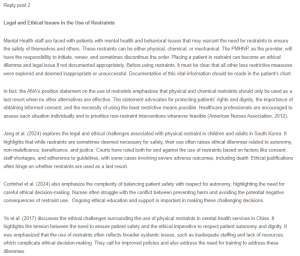Response – Legal and Ethical Concerns in Use of Restraints
Hello,
Thank you for your posting on legal and ethical issues associated with the use of restraints. In this regard, Zhou et al. (2024) denote that perceptions of autonomy and respect for authority create cultural influences in the use of restraints in healthcare settings. If respect for authority is deeply ingrained in certain cultures, then patients may be much less likely to question or oppose the use of restraints. This raises some serious ethical questions as to where true informed consent is obtained, as the patient may feel obliged rather than state a preference. Moreover, cultural perceptions of mental disorders and behavioral Note disturbances may further complicate decisions about the use of restraints. In some cultures, for example, there is much greater family involvement in decision-making related to health care, and this may be either helpful or an obstacle to the use of least restrictive interventions, depending upon their perspectives. Healthcare practitioners must then be culturally sensitive and observant of such dynamics to balance respect for patient autonomy and authority with the minimization of harm while ensuring informed consent is genuinely obtained.
References
Zhou, J., Qin, Q., Chen, S., & Zhang, H. (2024). Moral dilemmas regarding physical restraints in intensive care units: Understanding autonomy, beneficence, non-maleficence and justice in the use of physical restraints. Journal of Multidisciplinary Healthcare, 17(17), 1619–1627. https://doi.org/10.2147/JMDH.S455910
ORDER A PLAGIARISM-FREE PAPER HERE
We’ll write everything from scratch
Question 
Reply post 2
Legal and Ethical Issues in the Use of Restraints
Mental Health staff are faced with patients with mental health and behavioral issues that may warrant the need for restraints to ensure the safety of themselves and others. These restraints can be either physical, chemical, or mechanical. The PMHNP, as the provider, will have the responsibility to initiate, renew, and sometimes discontinue the order. Placing a patient in restraint can become an ethical dilemma and legal issue if not documented appropriately. Before using restraints, it must be clear that all other less restrictive measures were explored and deemed inappropriate or unsuccessful. Documentation of this vital information should be made in the patient’s chart.

Response – Legal and Ethical Concerns in Use of Restraints
In fact, the ANA’s position statement on the use of restraints emphasizes that physical and chemical restraints should only be used as a last resort when no other alternatives are effective. The statement advocates for protecting patients’ rights and dignity, the importance of obtaining informed consent, and the necessity of using the least restrictive means possible. Healthcare professionals are encouraged to assess each situation individually and to prioritize non-restraint interventions whenever feasible (American Nurses Association, 2012).
Jang et al. (2024) explores the legal and ethical challenges associated with physical restraint in children and adults in South Korea. It highlights that while restraints are sometimes deemed necessary for safety, their use often raises ethical dilemmas related to autonomy, non-maleficence, beneficence, and justice. Courts have ruled both for and against the use of restraints based on factors like consent, staff shortages, and adherence to guidelines, with some cases involving severe adverse outcomes, including death. Ethical justifications often hinge on whether restraints are used as a last resort.
Cortinhal et al. (2024) also emphasize the complexity of balancing patient safety with respect for autonomy, highlighting the need for careful ethical decision-making. Nurses often struggle with the conflict between preventing harm and avoiding the potential negative consequences of restraint use. Ongoing ethical education and support is important in making these challenging decisions.
Ye et al. (2017) discusses the ethical challenges surrounding the use of physical restraints in mental health services in China. It highlights the tension between the need to ensure patient safety and the ethical imperative to respect patient autonomy and dignity. It was emphasized that the use of restraints often reflects broader systemic issues, such as inadequate staffing and lack of resources, which complicate ethical decision-making. They call for improved policies and also address the need for training to address these dilemmas.
Nielson et al. (2021) also discusses the legal implications of physical restraints on children and adolescents, highlighting the risk of violating legal standards designed to protect this vulnerable population. It emphasizes that improper use of restraints can lead to legal consequences, including potential lawsuits and penalties for failing to adhere to established guidelines and regulations. The misuse of restraints on children can be considered maltreatment or abuse which may lead to criminality.
Physical and mechanical restraints are often used in my setting. The order is valid for four hours and is renewed as often if necessary. It is imperative that the provider has a face-to-face assessment with the patient prior at initiation and before each renewal. The least restrictive measure must be always used, and patients are not 1:1 monitoring for safety. The information is applicable to my clinical setting, as it helps staff to understand that evidence-based research has shown there are legal and ethical principles in restraints application. In the state of Virginia, law 12VAC35-115-110 governs the use of seclusion, restraint, and time out, and is congruent with the ethical and legal standards found in these articles (RIS, Virginia Law, 2024).
References
American Nurses Association (2012). Position Statement: The Use of Restraint and
Seclusion. American Nurses Association. https://www.nursingworld.org/~48f80d/globalassets/practiceandpolicy/nursing-excellence/ana-position-statements/nursing-practice/restraints-position-statement.pdf.
Cortinhal, V. S. J., Correia, A. S. C., & Deodato Fernandes, S. J. (2024). Nursing Ethical